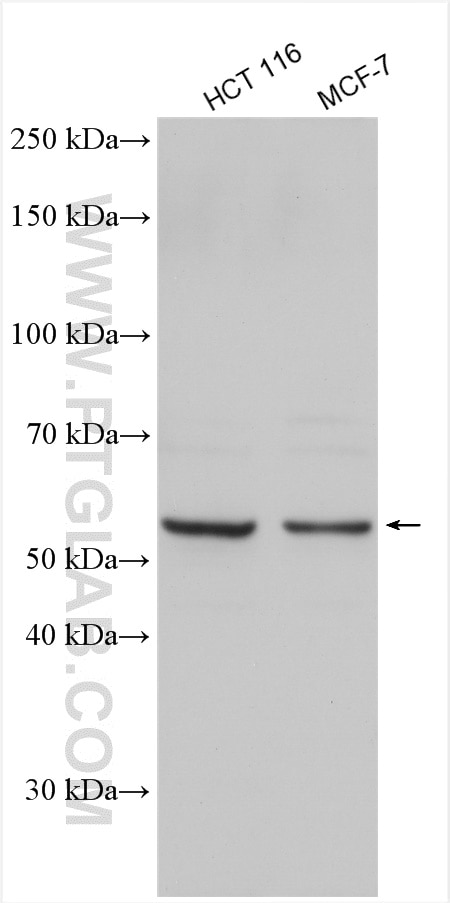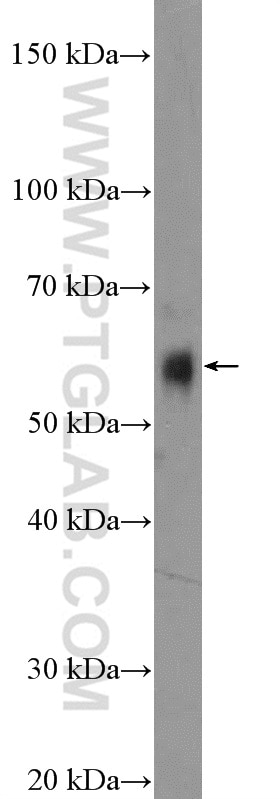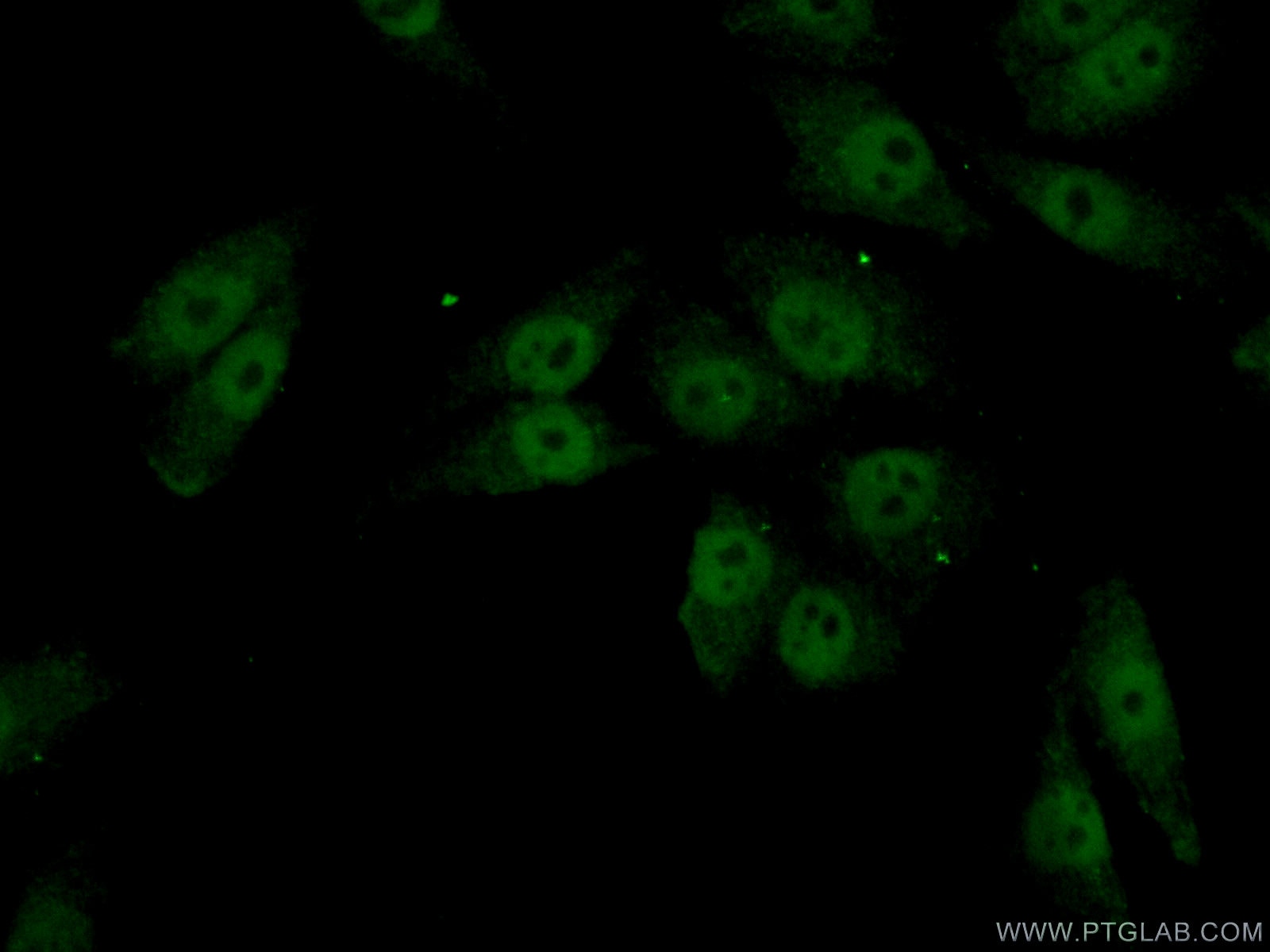Validation Data Gallery
Tested Applications
| Positive WB detected in | HCT 116 cells, rat spleen tissue, MCF-7 cells |
| Positive IF/ICC detected in | A375 cells |
Recommended dilution
| Application | Dilution |
|---|---|
| Western Blot (WB) | WB : 1:500-1:1000 |
| Immunofluorescence (IF)/ICC | IF/ICC : 1:50-1:500 |
| It is recommended that this reagent should be titrated in each testing system to obtain optimal results. | |
| Sample-dependent, Check data in validation data gallery. | |
Published Applications
| KD/KO | See 3 publications below |
| WB | See 13 publications below |
| IHC | See 2 publications below |
| IF | See 5 publications below |
Product Information
23066-1-AP targets FOXC2 in WB, IHC, IF/ICC, ELISA applications and shows reactivity with human, mouse, rat samples.
| Tested Reactivity | human, mouse, rat |
| Cited Reactivity | human, mouse, rat |
| Host / Isotype | Rabbit / IgG |
| Class | Polyclonal |
| Type | Antibody |
| Immunogen | FOXC2 fusion protein Ag19378 相同性解析による交差性が予測される生物種 |
| Full Name | forkhead box C2 (MFH-1, mesenchyme forkhead 1) |
| Calculated molecular weight | 501 aa, 54 kDa |
| Observed molecular weight | 54-68 kDa |
| GenBank accession number | BC113437 |
| Gene Symbol | FOXC2 |
| Gene ID (NCBI) | 2303 |
| RRID | AB_2879204 |
| Conjugate | Unconjugated |
| Form | Liquid |
| Purification Method | Antigen affinity purification |
| UNIPROT ID | Q99958 |
| Storage Buffer | PBS with 0.02% sodium azide and 50% glycerol , pH 7.3 |
| Storage Conditions | Store at -20°C. Stable for one year after shipment. Aliquoting is unnecessary for -20oC storage. |
Background Information
Forkhead box protein C2 (FOXC2) also known as forkhead-related protein FKHL14 (FKHL14), transcription factor FKH-14, or mesenchyme fork head protein 1 (MFH1) is a protein that in humans is encoded by the FOXC2 gene. FOXC2 is a member of the fork head box (FOX) family of transcription factors. FOX transcription factors are expressed during development and are associated with a number of cellular and developmental differentiation processes. FOXC2 is required during early development of the kidneys, including differentiation of podocytes and maturation of the glomerular basement membrane. It is also involved in the early development of the heart. FOXC2 is also involved in cancer metastases. In particular, expression of FOXC2 is induced when epithelial cells undergo an epithelial-mesenchymal transition (EMT) and become mesenchymal looking cells. (PMID: 8674414 9169153 19935708) This antibody recognizes the 56 kDa FOXC2 protein, but the phosphorylated FOXC2 may be a 56-65 kDa protein. The 62kDa band was also detected in the study(PMID: 19540201).
Protocols
| Product Specific Protocols | |
|---|---|
| WB protocol for FOXC2 antibody 23066-1-AP | Download protocol |
| IF protocol for FOXC2 antibody 23066-1-AP | Download protocol |
| Standard Protocols | |
|---|---|
| Click here to view our Standard Protocols |
Publications
| Species | Application | Title |
|---|---|---|
Theranostics Hypoxia-induced feedback of HIF-1α and lncRNA-CF129 contributes to pancreatic cancer progression through stabilization of p53 protein.
| ||
Clin Transl Med VEGF-C/VEGFR-3 axis protects against pressure-overload induced cardiac dysfunction through regulation of lymphangiogenesis. | ||
Exp Cell Res Long non-coding RNA GClnc1 knockdown suppresses progression of epithelial ovarian cancer by recruiting FOXC2 to disrupt the NOTCH1/NF-κB/Snail pathway. | ||
Am J Transl Res Naringin promotes osteogenic differentiation of bone marrow stromal cells by up-regulating Foxc2 expression via the IHH signaling pathway. | ||
Acta Biochim Biophys Sin (Shanghai) STK33 plays an important positive role in the development of human large cell lung cancers with variable metastatic potential. | ||
Cell Death Dis Decreased ZNF750 promotes angiogenesis in a paracrine manner via activating DANCR/miR-4707-3p/FOXC2 axis in esophageal squamous cell carcinoma. |


